
György Konecsni (1908 - 1970)
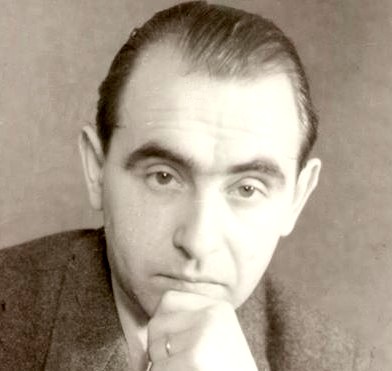
György Konecsni
György Konecsni was an artist best known for his poster designs during the 1930s as well as for his postage stamp artwork following the Second World War. Not much is said about his childhood. He studied painting at the Hungarian Academy of Fine Arts beginning in 1927 at the age of 19, completing his studies in 1931. On the face of it, it appears curious that someone trained in the fine arts would have chosen a career in poster art which was designed to sell products, travel and governmental programs. However, as classmate and friend Lajos Szalay explains, "My generation at that time was frightened by the concept of art. ...we saw that once we got out into life, none of us would be [successful]. The only one who succeeded was Konecsni, who learned poster art thanks to his fall." (Katalin Bakos, "Ellentétek szintézise. Konecsni György plakátművészete 1932-1948", Hungarian National Gallery, 2005, p. 5)
Konecsni's 'fall' refers to his arrest in 1932 arrest for "subversive activities against the state and social order" according to Szalay. Konecsni and fellow artist József Pituk wrote an article for the newspaper about the situation of college students with Lipták adding sections to the article containing socialist slogans. The Hungarian police got hold of the article and the two students were sentenced to serve four months in jail. Although he leaned left-wing, Szaly notes that Knoecsni wasn't a part of the labor movement.
If Szaly is to be believed, Konecsni's move into commercial advertising art was due in part to the time
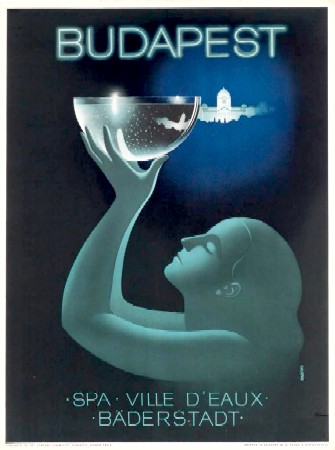
Travel Poster, Budapest Spa Town, 1935, Invaluable
he spent in jail. Konecsni entered and won two contests in 1932, one for Budapest spas ('Bathe in the Medicinal Water' - see the image at left) and the other for the MAV Accident Insurance Fund. Neither of them were actually used officially published as advertisements, although this didn't bother him. He kept the submitted posters for later reference, preserving most of his following poster designs as well. When clients used his posters but changed them in ways he didn't like, he kept the originals and repainted them in their original form. This is how he came to have his original designs for use at the first National Poster Exhibition in 1948.
Konecsni was asked to create tourist posters which had become popular in the early 1930s. The state was intensely interested in attracting tourists following the economic crisis that began in 1929. These were designed to be displayed in tourists offices, waiting rooms and shop windows as well as be displayed at exhibitions such as the Budapest International Fair, the National Agricultural Exhibition and Fair and the Autumn Home Furnishing Fair.
During the 1930s, Konecsni received a variety of awards for his poster designs. At the 1934 international tourism exhibition in Rome, he won the Fuad Cup, the traveling cup of the International Tourism Association, for his poster of a Girl with a Butterfly advertising Hungary for the Hungarian National Council of Tourist Traffic Budapest. (See the first image below.) At the 1936 National Salon international tourism exhibition he won the Most Impressive Poster award for his spa towns of Budapest poster (see the second image below) as well as the prize for the most beautiful poster - one depicting a duck in flight over water for Hortobay National Park - as selected by the public. The Hortobay poster won him the Fuad Cup a second time at the 1936 Lucerne international tourism exhibition. He received the Grand Prix award given by foreign poster experts for the posters he designed for the Publicité pavilion at the 1937 World's Fair in Paris. He was awarded another Grand Prix for three posters displayed at the 1939 Milan International Triennial of Applied Arts.
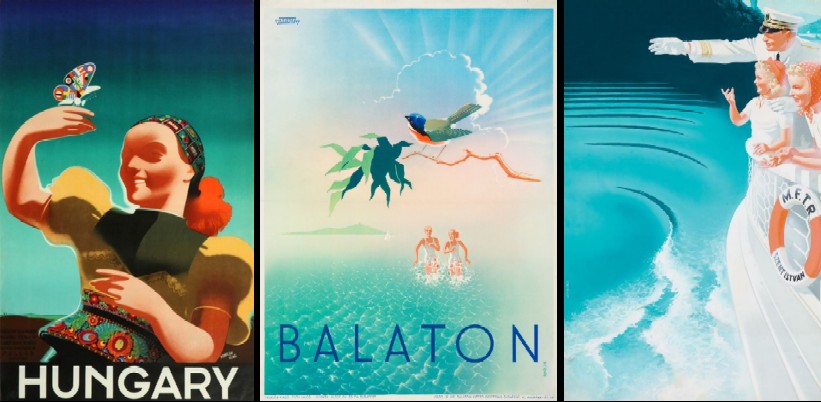 Some of Konecsni's Travel Advertisement Posters, From left - Hungary, 1930, PosterTeam; Lake Balaton, 1940, Europeana; Ship Journey in Danube Bend, 1930s, Invaluable
Some of Konecsni's Travel Advertisement Posters, From left - Hungary, 1930, PosterTeam; Lake Balaton, 1940, Europeana; Ship Journey in Danube Bend, 1930s, Invaluable
In addition to travel posters, Konecsni created posters for commercial interests in the 1930s. Among his commercial clients were Meinl coffee, Kakas shoe paste, Palma-Okma shoe heels, Emergé bicycle tires, Dorogi coal, Pucc cleaning agent, Bader Coali skin care cream and Senator cigarettes. His most important commercial client was Gas Works, who used his artwork for several campaigns (see the first image below for an example). His pipe man mascot and three tongued flame remained in use at the company beyond World War II. Those posters tended to be abstract and very colorful, allowing the viewer to make the connection between the images and the products.
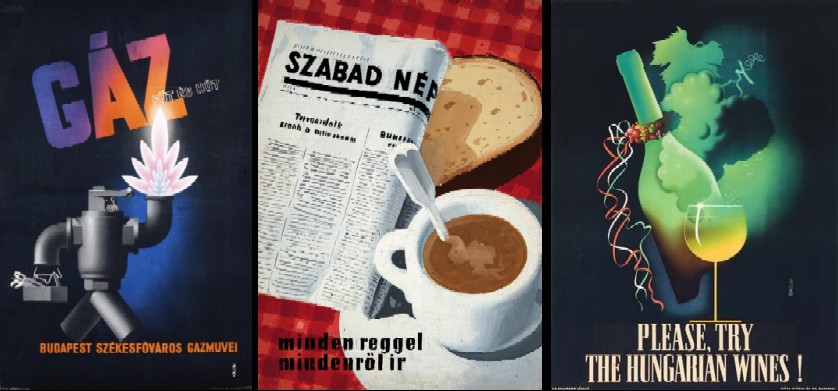 Some of Konecsni's Product Advertisement Posters, From left - Gaz Works, 1937, Vintage Everyday; Szabad Nep Newspaper, 1940s, Invaluable; György Hungarian Wines, undated, Swann Galleries
Some of Konecsni's Product Advertisement Posters, From left - Gaz Works, 1937, Vintage Everyday; Szabad Nep Newspaper, 1940s, Invaluable; György Hungarian Wines, undated, Swann Galleries
 More of Konecsni's Product Advertisement Posters, From left - Cordatic Pneu Tires, 1930s, Budapest Poster Gallery; Baeder Caola, Vitamin Face and Skin Care Cream for Sports and Sunbathing, 1938; Peti Salt Fertilizer, 1940s, Budapest Poster Gallery
More of Konecsni's Product Advertisement Posters, From left - Cordatic Pneu Tires, 1930s, Budapest Poster Gallery; Baeder Caola, Vitamin Face and Skin Care Cream for Sports and Sunbathing, 1938; Peti Salt Fertilizer, 1940s, Budapest Poster Gallery
Due to the success of his posters, Konecsni was asked to decorate the tourism room at the Hungarian pavilion of the 1937 World's Fair in Paris. He was given the Diplome d'Honneur for design. He also designed a variety of advertising posters for events including the 1941 Budapest International Fair, the Bern exhibition, and the 6th National Fine Arts Exhibition held in Cluj-Napoca. He also created brochures and wall stickers during this period.
Konecsni continued to create posters after the end of the second world war, winning recognition for his work including a Gold Medal from the Association of Applied Arts in 1948, two more gold medals from the Order of Merit of the Republic in 1950 and 1952, the Kossuth Prize in 1954 and another Gold Medal of the Order of Merit of Labor in 1968. After 1945, he designed several political posters such as 'Never again!' (1945) and 'The bread begins here' (1947). The Budapest Poster Gallery said he was "the engine of the development of political poster art, imbuing the genre with new quality" following the rise of the Hungarian Communist Party after the war. ("Konecsni György, 1908 - 1970". Budapest Poster website, gathered 5-8-25) He also painted or co-painted large historical panels in the early 1950s with a similar political message.
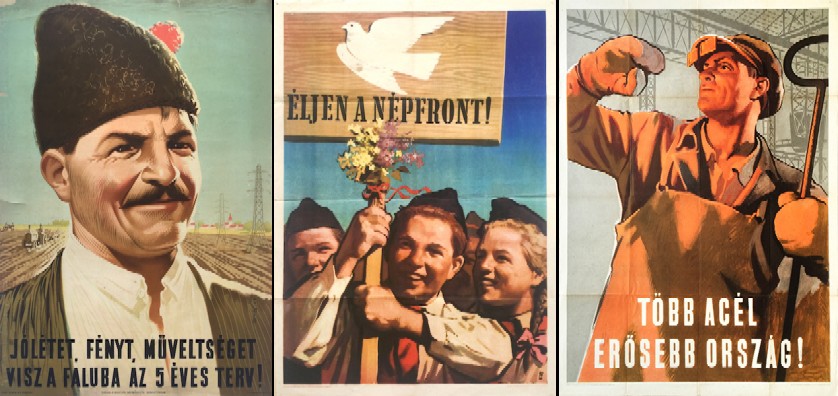 Some of Konecsni's Political Posters, From left - György Konecsni, The Five Year Plan, 1950; Long Live the People's Front, 1953; More Steel, Stronger Nation, 1953 - All From Budapest Poster
Some of Konecsni's Political Posters, From left - György Konecsni, The Five Year Plan, 1950; Long Live the People's Front, 1953; More Steel, Stronger Nation, 1953 - All From Budapest Poster
Between 1940 and 1950 Konecsni designed stamps, indicating his popularity as an artist even during World War II. He designed all but two of the series of new Hungarian stamps in 1945 and 1946.
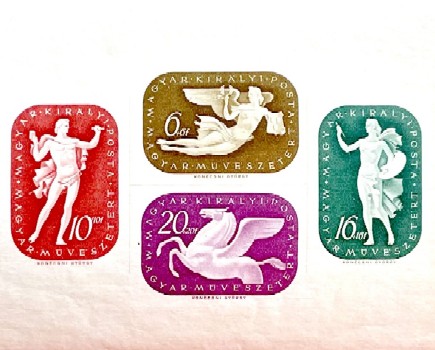
Souvenir Sheet 'Art Assistance' Stamps, 1941, Ebay
His War Leaders series and Famous Women series designed during the war remained in circulation for years after it ended.
As the communist dictatorship became more oppressive in the 1950s, he was forced to create posters in a 'socialistic realistic' style. He eventually stopped designing posters for the government. Beginning in the 1960s, he started painting murals for public spaces, mosaics, sgraffitos (art made by painting multiple layers and scratching off the top layer to reveal the color underneath) and decorative wall paintings commissioned by the government. These tend to be more abstract and intellectual, still utilizing stylized geometric forms and surrealistic images.
Of his style, which evolved over Konecsni's lifetime, the Budapest Poster Gallery says,
In this early period [of the 1930s], Konecsni used flat geometric forms and simple colours; yet his style soon changed, and he turned toward a more decorative and classicist artistic world. He created beautiful compositions, mainly with antique forms and soft surfaces, made by spray painting. He designed remarkable advertisements for many of the spas of Budapest, and for other tourist attractions, like Balaton, Hortobágy, etc. Konecsni also drew inspirations from folk art, which was in fashion during the interwar period due to the increasing nationalism of society. Konecsni managed to depict figures dressed in traditional clothing in a way that was acceptable also for the modern tastes. His tourism posters, for example, present national costume design in a bright harmonic world. ("Konecsni György, 1908 - 1970")
Not Cited Above:
"Szalay Lajos", Hungarian Wikipedia, gathered 12-9-24
"Konecsni György", Hungarian Wikipedia, gathered 12-9-24
"Konecsni György", Artportal via Archive.org, gathered 12-9-24
"Artworks by Gyorgy Konecsi", Hungarian National Gallery, gathered 12-9-24 -